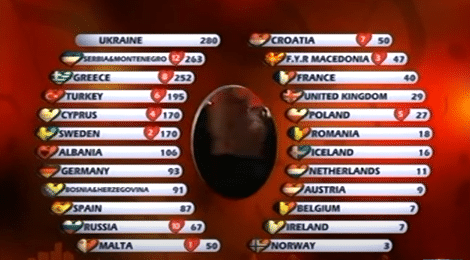Throwback to Istanbul – Eurovision 2004
As the transmission of the Contest from Riga back on the 24th of May 2003 came to its end, the news was everywhere to be heard: Turkey got their first Eurovision victory 28 years after its debut thanks to Sertab Erener and her song “Every Way That I Can”. Europe was to experience the first Turkish hosting the following year. This Thursday, we are doing a throwback to Eurovision 2004.
As the clocks around Central Europe showed 9 PM on Wednesday 12th of May 2004, all eyes were on Istanbul. This time the city will be in the centre of attention twice in the same week as it was the first time Eurovision had a semi-final round in addition to the grand final.
The transmission opens with the traditional “Te Deum” and right afterwards the cameras around the Abdi Ipekci Arena take control. The show did not have an opening act and shortly after the hosts got to the stage it was the turn of Finland to open the night. 22 countries were competing in the semi-final round, four of which were having their debut. They were Albania, Andorra, Belarus and Serbia & Montenegro. The show opener – Finland was back in the Contest after missing last year’s one, same as Denmark, Lithuania, North Macedonia and Switzerland, whilst Monaco was back after a 24 year-long absence.
As the 2 hours show was coming to its end, the hosts announced which 10 countries out of 22 semi-finalists made it to the final. They were announced in random order – Serbia & Montenegro, Malta, The Netherlands, Albania, Ukraine, Croatia, Bosnia & Herzegovina, North Macedonia, Greece and Cyprus. They were awaited by the Big 4 in the Grand Final, together with the previous year’s top 11 qualifiers. The automatic qualifiers were the members of the Big 4 (France, Germany, Spain and the United Kingdom) as well as the top 10 countries from the previous contest (apart from the Big 4). Although ranked 11th in 2003, Ireland automatically qualified to the final, as Spain’s 8th position ranking in 2003 made it possible for the 11th place to automatically qualify as well. For the first, and the only time ever, the results of the non-qualifiers were revealed on the screen, moments after the 10 qualifiers were announced. However, those results turned out to be incorrect, after the show.
After the Final, it was revealed that the debuting Serbia and Montenegro won the semi-final with a slight margin of 7 points from the runner-up Ukraine. The list of qualifiers had a strong eastern presence as 8 of the 10 qualifiers were countries of Eastern Europe and with all former Yugoslav countries in exception of Slovenia making it to the final. The only Western European qualifiers were Malta and The Netherlands.
The entire show is available on Youtube, with BBC’s commentary by Paddy O’Connell:
The night of the Final all eyes were once again on Istanbul. The show started with a short sightseeing of Istanbul and quickly moved to the arena where a not less important Turkish icon was waiting. Sertab Erener appears on stage joined by 4 male dancers followed by an immense cheer from the crowd and starts singing her winning entry joined by the crowd and then moves to another song of hers called “Leave”.
The show started with Spain and the representatives go on stage one after the other hoping to be the winners of that night. That contest included numerous artists which became Eurovision stars and icons such as Željko Joksimović who would assist in the composition of numerous entries in the years to follow, Sakis Rouvas who would represent Greece once again in 2009 in Moscow and Deen (Fuad Backović) from Bosnia & Herzegovina who would be back on the Eurovision stage 12 years later in Stockholm. But all this worked for one only contestant – by the end of the voting process, it was clear that the first position was occupied by no one else but Ruslana from Ukraine, who, with 280 points and only four times a score of 12 points, would bring the contest to her country the following year. The victory came in Ruslana’s favour as her career rose to new heights with numerous albums in both English and Ukrainian, as well as many awards winning and appearances in national finals and reality shows throughout her post-Eurovision career. Serbia and Montenegro who got 9 sets of 12 points got to the 2nd position and Greece got to the 3rd position with 7 sets of 12 points.
Watch the winning act here:
Although the voting indicated Ukraine as the clear winner of that edition of the contest the scoreboard had many other records hidden in it: For the first time in the contest’s history all top 3 entries managed to get over 200 points. Up until this edition of the Contest, a score of over 200 points was only earned by two previous winners – Paul Harrington and Charlie McGettigan in 1994 for Ireland, and Katrina and The Waves in 1997 for the United Kingdom.
With Ukraine, Serbia and Montenegro, Greece, Turkey and Cyprus occupying the top 5 positions and with 7 out of the top 10 positions being occupied by Eastern countries that year showed that in opposition with the ’90s, the East has its presence and it is here to stay. This strong presence of Eastern countries will show in the following editions as more and more of these countries get high ranks and also their first victories.

2004 was also the first year that Svante Stokselius was the Executive Supervisor of the Eurovision Song Contest. He replaced Sarah Yuen, who was in charge of the 2003 Contest only. It was also the first time that Sven Stojanović, a Swedish TV producer with Serbian origins, acted as the Executive Producer of Eurovision, which he would repeat four more times (up to date).
The Grand Final of the 2004 Contest is available on Youtube, with Terry Wogan’s commentary:

